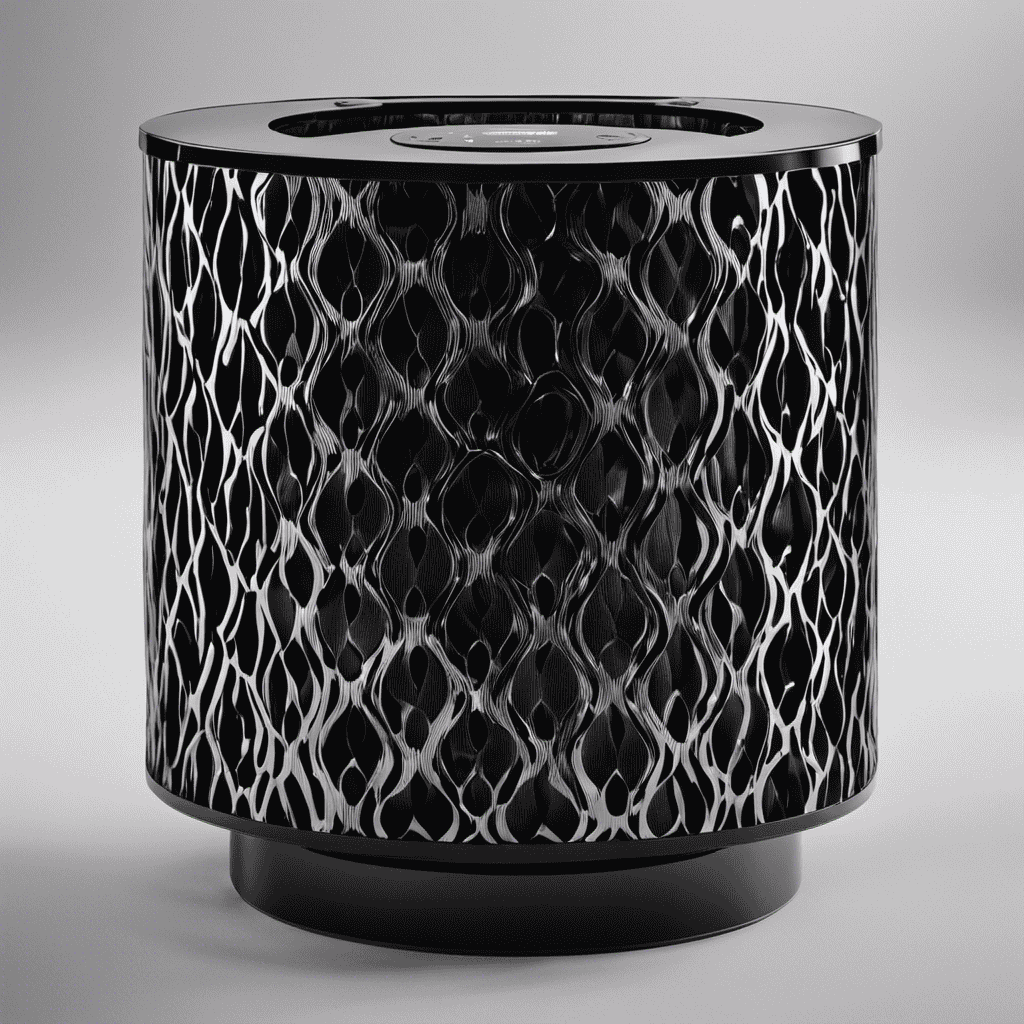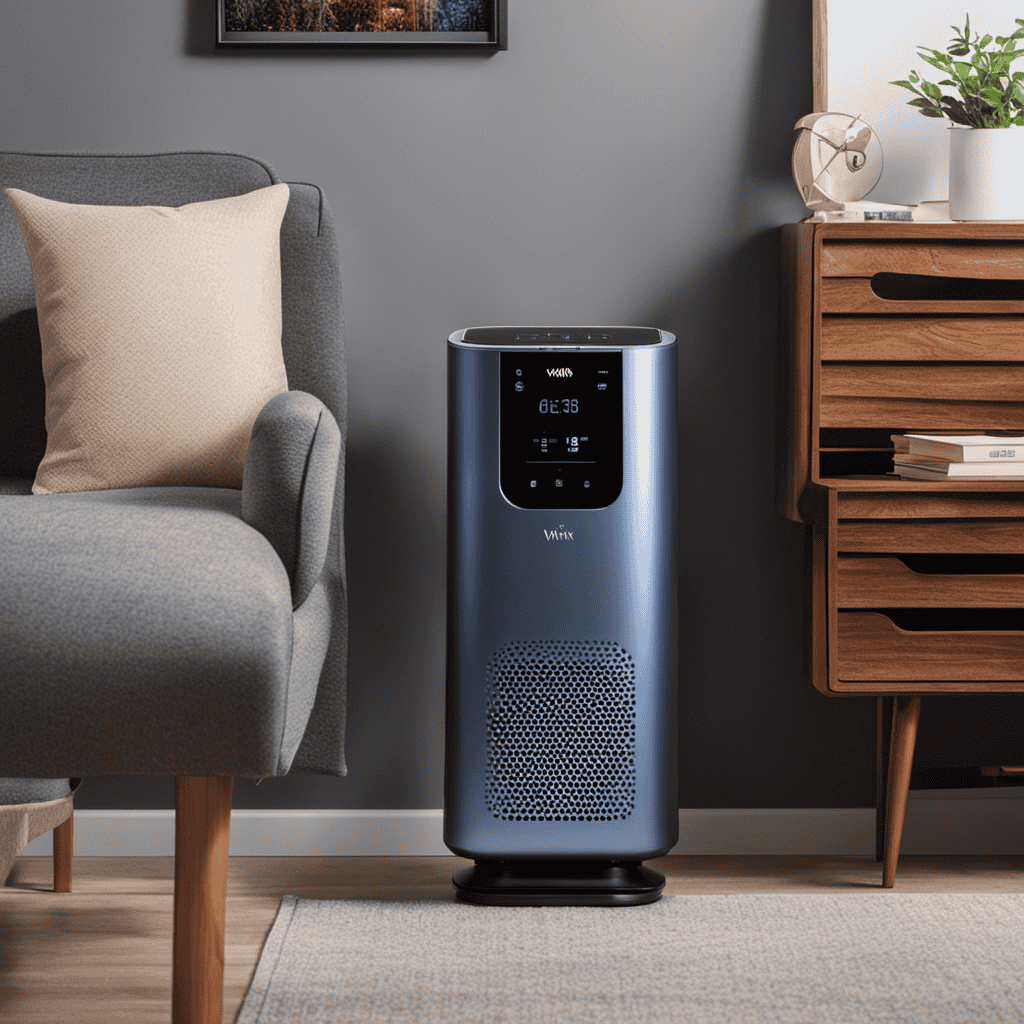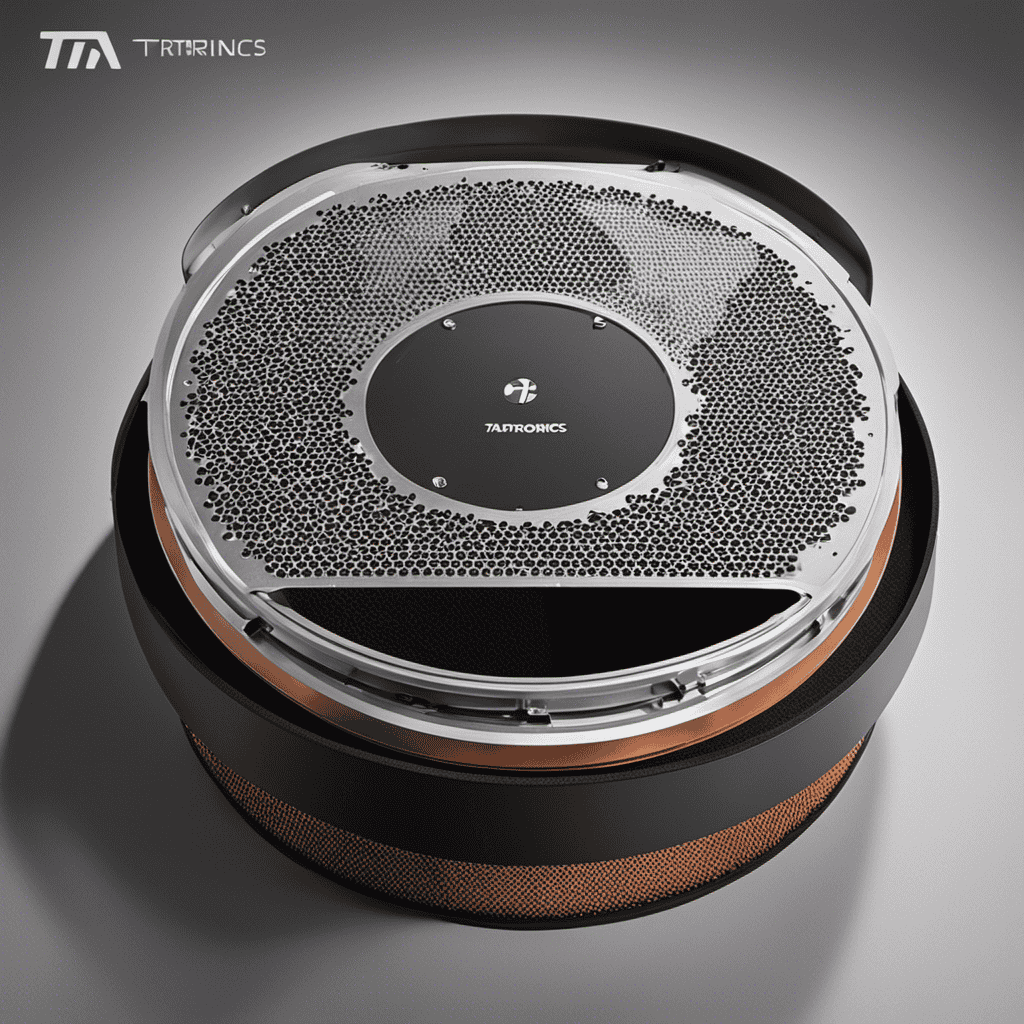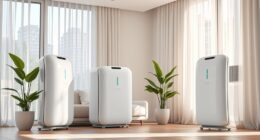So, I was stunned to find my air purifier filter had turned black in just 48 hours. It was quite the surprise, to be honest. However, worry not, because I’ve thoroughly investigated this problem to provide you with the solutions you’re looking for.
In this article, we will explore the possible causes of rapid filter discoloration, the importance of regular maintenance, and tips to extend the lifespan of your air purifier filter.
Let’s unravel this mystery together and ensure cleaner, healthier air in our homes.
Key Takeaways
- Regular maintenance is crucial for optimal air purification and to prevent filter discoloration.
- Understanding the sources of indoor pollution and taking actions to reduce pollutant sources can help improve air quality and prevent filter discoloration.
- Choosing the right air purifier size for your space is important to ensure optimal performance and prevent unnecessary energy consumption.
- Regularly cleaning or replacing the air purifier filter is essential for extending its lifespan and maintaining efficient air purification.
Possible Causes of Rapid Filter Discoloration
There are several factors that could have caused your air purifier filter to turn black in just 2 days.
The discoloration of the filter is typically a result of the accumulation of airborne particles and pollutants.
One possible cause is high levels of indoor air pollution, such as smoke, dust, or pet dander. These particles can quickly build up on the filter, leading to its black appearance.
Another potential cause is a malfunctioning air purifier. If the purifier is not functioning properly, it may not be effectively trapping and removing pollutants, causing the filter to become dirty more quickly.
To prevent rapid filter discoloration, it is crucial to address the root causes. This may involve improving indoor air quality through proper ventilation, reducing pollutant sources, and regularly maintaining the air purifier to ensure its optimal performance.
Understanding the Air Quality in Your Home
It’s important to understand the air quality in your home to determine the cause of your air purifier’s filter turning black so quickly. Indoor pollution can arise from various sources, and poor air quality can have detrimental effects on our health. To better comprehend the air quality in your home, you can consider conducting air quality tests or monitoring devices. These measures will provide valuable insights into the pollutants present and their concentrations. By understanding the causes of indoor pollution, such as volatile organic compounds (VOCs) from cleaning products or mold spores from damp areas, you can take appropriate actions to reduce these sources and improve the air quality. This will not only help your air purifier perform better, but also promote a healthier living environment for you and your loved ones.
| Potential Causes of Indoor Pollution | Health Effects of Poor Air Quality |
|---|---|
| Volatile Organic Compounds (VOCs) | Respiratory Issues |
| Mold and Mildew | Allergies |
| Dust and Pet Dander | Asthma Attacks |
Factors That Contribute to Filter Discoloration
When it comes to maintaining clean air quality in our homes, understanding the types of pollutants present and how they affect our air filters is essential.
Air pollutants can come from a variety of sources, such as dust, pet dander, and smoke, and they can accumulate on our filters over time.
To ensure effective filter maintenance, it is important to regularly clean or replace the filters according to the manufacturer’s recommendations and to keep the surrounding area clean to minimize the introduction of new pollutants.
Air Quality and Pollutants
The black color of my air purifier filter in just 2 days indicates high levels of pollutants in the air. Air pollution is a serious issue that affects both indoor and outdoor environments.
Indoor pollutants can come from a variety of sources, such as cooking, cleaning products, and tobacco smoke. These pollutants can include particulate matter, volatile organic compounds (VOCs), and gases like carbon monoxide. The accumulation of these pollutants in the air can lead to poor indoor air quality, which can have negative effects on our health.
It is important to address this issue by using air purifiers and regularly maintaining the filters to ensure clean and healthy air. Transitioning into the subsequent section about ‘filter maintenance tips’, it is crucial to understand the importance of proper filter maintenance to maximize the effectiveness of the air purifier.
Filter Maintenance Tips
To keep your air purifier running efficiently, remember to regularly clean or replace the filter.
The filter is responsible for capturing dust, allergens, and other particles from the air, so it can quickly become dirty and clogged.
If your filter turned black in just two days, it indicates a high level of pollutants in your environment. It’s important to address this issue as it can affect the performance of your air purifier.
To clean the filter, gently vacuum or rinse it with water, following the manufacturer’s instructions. However, if the filter is too dirty or damaged, it’s best to replace it with a new one.
Regular filter replacement and proper cleaning techniques will help ensure that your air purifier continues to provide clean and fresh air.
The Importance of Regular Maintenance for Air Purifiers
Dirty air can pose significant health risks, making it crucial to maintain air purifiers regularly. Regular maintenance not only helps extend the lifespan of the filters but also ensures optimal air purification.
Dirty Air, Health Risks
You should be concerned about the health risks associated with breathing in dirty air. Air pollution can have severe effects on our health, both in the short term and long term. Here are some key points to consider:
- Exposure to air pollution can lead to respiratory problems such as asthma and bronchitis.
- It can also increase the risk of heart disease and stroke.
- Long-term exposure to dirty air has been linked to lung cancer and other respiratory diseases.
Breathing in polluted air can have serious consequences for our well-being. Therefore, it is crucial to take steps to reduce air pollution and protect ourselves from its harmful effects. One way to do this is by using air purifiers with clean and efficient filters.
In the next section, I will discuss how to extend the lifespan of your air purifier filter to ensure it continues to effectively remove pollutants from the air.
Extend Filter Lifespan
By regularly cleaning and maintaining my air purifier’s filter, I can prolong its lifespan and effectively reduce the need for frequent filter replacements.
Air purifiers are designed to remove pollutants from the air, but over time, the filter becomes clogged with dirt, dust, and other particles. This can cause the filter to turn black and reduce its efficiency.
To extend the filter’s lifespan, it is important to follow the manufacturer’s recommendations for cleaning and replacing the filter. Regularly vacuuming or washing the filter can help remove trapped particles and prevent them from accumulating.
Additionally, keeping the air purifier in a clean environment and avoiding smoking or other activities that release pollutants can also help reduce the need for frequent filter replacements.
Optimal Air Purification
To ensure optimal air purification, it’s important to follow the recommended guidelines for cleaning and maintaining your air purifier. Here are three key techniques to improve air quality and maximize the effectiveness of your air purifier:
-
Regularly clean and replace filters: Filters are essential for trapping and removing pollutants from the air. Over time, they can become clogged and lose their efficiency. Cleaning or replacing filters as recommended by the manufacturer will ensure optimal performance.
-
Keep the air purifier in the right location: Proper placement is crucial for effective air purification. Be sure to position the purifier in an area where it can circulate air freely and remove pollutants efficiently.
-
Consider the size of your space: Air purifiers come in different sizes, and it’s important to choose one that is suitable for the size of your room. Using an undersized purifier may result in poor air quality, while an oversized purifier can lead to unnecessary energy consumption.
Tips for Extending the Lifespan of Your Air Purifier Filter
One way to extend the lifespan of your air purifier filter is by regularly cleaning and maintaining it. Proper care of your filter can help reduce the frequency of filter replacements and save you money in the long run.
The filter replacement frequency varies depending on factors such as the air quality in your area and the usage of your air purifier. However, as a general guideline, it is recommended to replace your air purifier filter every 6 to 12 months.
In addition to regular replacements, you can also prolong the lifespan of your filter by performing DIY air purifier filter cleaning. This involves gently vacuuming or rinsing the filter to remove accumulated dust and debris.
Regular maintenance and cleaning will ensure that your air purifier filter continues to effectively capture pollutants and provide cleaner air for your home.
How to Properly Clean and Maintain Your Air Purifier
When it comes to cleaning and maintaining your air purifier, there are several key points to consider.
First, it is important to determine how often the cleaning should be done, as this can vary depending on factors such as the type of air purifier and the environment it is in.
Secondly, understanding the proper cleaning techniques is crucial to ensure effective removal of pollutants and contaminants.
Lastly, regular maintenance is of utmost importance to keep the air purifier running efficiently and to prolong its lifespan.
Cleaning Frequency: How Often
You should consider cleaning your air purifier filter more frequently if it turned black in just 2 days. Maintaining a clean air purifier filter is crucial to ensure its optimal performance.
Here are some key points to consider when it comes to cleaning frequency:
-
Regular cleaning techniques: Dust and debris can accumulate on the filter over time, reducing its effectiveness. Regularly vacuuming or washing the filter can help remove these particles and improve its efficiency.
-
Filter replacement: Even with regular cleaning, air purifier filters have a limited lifespan. It is important to check the manufacturer’s guidelines for filter replacement intervals and follow them accordingly.
-
Environmental factors: The frequency of cleaning may also depend on the surrounding environment. If you live in a highly polluted area or have pets, the filter may require more frequent cleaning or replacement.
Proper Cleaning Techniques
Regularly cleaning your air purifier’s filter is essential for maintaining its optimal performance. Proper cleaning techniques can help remove dust, debris, and other contaminants, ensuring that your air purifier continues to effectively clean the air in your home.
To clean the filter, first, turn off and unplug the air purifier. Remove the filter according to the manufacturer’s instructions. Gently tap the filter to remove any loose particles. Next, use a soft brush or vacuum cleaner with a brush attachment to gently remove any remaining debris.
If the filter is washable, rinse it with water and let it air dry completely before reinstalling. If the filter is not washable, replace it with a new one.
Regular maintenance and proper cleaning techniques will help prolong the life of your air purifier and ensure cleaner, fresher air in your home.
Importance of Regular Maintenance
Regular maintenance is crucial for ensuring that your air purifier continues to function effectively. By properly maintaining your air purifier, you can reap the benefits of clean air and improve the overall air quality in your home or office.
Here are three important reasons why air purifier maintenance is essential:
-
Prolongs the lifespan of your air purifier: Regular maintenance, such as cleaning or replacing filters, helps prevent clogging and ensures proper airflow, which can extend the lifespan of your air purifier.
-
Maximizes air purification efficiency: A well-maintained air purifier can effectively capture and remove airborne particles, allergens, and pollutants, resulting in cleaner, healthier air.
-
Saves energy and reduces costs: A properly maintained air purifier operates more efficiently, consuming less energy and reducing your electricity bills.
Maintaining your air purifier is not only essential for its longevity and efficiency but also for the health benefits of clean air. However, failure to properly maintain your air purifier can lead to filter discoloration, as we will discuss in the next section.
Common Mistakes That Lead to Filter Discoloration
If my air purifier filter turned black in just 2 days, it could be due to some common mistakes.
One of the main causes of filter clogging is the presence of indoor plants. While plants are known for their air purifying abilities, they can also release organic compounds that contribute to filter discoloration. These compounds, such as volatile organic compounds (VOCs), can be emitted from the soil, leaves, or flowers of indoor plants. When these VOCs come into contact with the filter, they can accumulate and cause it to turn black.
Additionally, poor maintenance practices can also lead to filter discoloration. Neglecting to regularly clean or replace the filter, or not using the air purifier at the appropriate settings, can result in a quicker buildup of particles and pollutants, leading to a blackened filter.
Therefore, it is important to properly care for and maintain your air purifier to prevent filter discoloration and ensure optimal air quality.
Signs That Your Air Purifier Might Not Be Working Properly
One way to determine if your air purifier is functioning properly is by checking for a lack of improvement in air quality. If you’ve been using your air purifier for some time and noticed that the air quality hasn’t improved, it may be a sign that the purifier is not effectively removing pollutants from the air.
To troubleshoot this issue, here are some techniques you can try:
- Check the filter: Make sure the filter is clean and not clogged with dust or debris.
- Adjust the settings: Ensure that the air purifier is set to the appropriate fan speed and mode for your specific needs.
- Consider the room size: If your air purifier is too small for the room, it may not be able to effectively clean the air.
Understanding the effectiveness of your air purifier and utilizing troubleshooting techniques can help ensure that you are breathing clean and healthy air in your home.
The Role of Pets in Filter Discoloration
To prevent your pets from causing discoloration in your filter, make sure to regularly groom them to minimize hair shedding. Pets, especially those with long hair, can shed a significant amount of fur, which can easily get trapped in the filter. This can lead to the accumulation of pet dander, dust, and other particles, causing the filter to turn black.
The role of allergies and the impact of smoking can also contribute to the discoloration of your air purifier filter. Allergies play a part as well, as pet dander can trigger allergic reactions in some individuals, leading to increased mucus production and the release of inflammatory substances, which can further contribute to filter discoloration. Additionally, smoking indoors can introduce harmful chemicals and particles into the air, which can also accumulate in the filter and cause discoloration.
Regularly cleaning and replacing your air purifier filter is essential to maintain its effectiveness and prevent discoloration.
How to Choose the Right Air Purifier for Your Home
When choosing the right air purifier for your home, consider the size of the room and the specific pollutants you want to target. To ensure you make an informed decision, here are some important factors to consider:
-
Air purifier effectiveness: Look for models that are proven to remove a wide range of pollutants, such as dust, pollen, pet dander, and mold spores. Check for certifications or third-party testing to verify their claims.
-
Air purifier features: Consider features like multiple fan speeds, a timer function, and a filter replacement indicator. These can enhance the convenience and efficiency of the purifier.
-
Room size coverage: Make sure the air purifier is suitable for the size of the room you intend to use it in. Most air purifiers provide a recommended room size for optimal performance.
Steps to Take When Your Air Purifier Filter Turns Black in 2 Days
If your air purifier’s filter is turning black in just two days, you may need to consider adjusting the settings or replacing the filter. Understanding filter efficiency is crucial in maintaining clean indoor air. Indoor air pollution sources, such as dust, pet dander, and smoke, can quickly accumulate in the air and cause the filter to become dirty. To address this issue, it is important to ensure that your air purifier is properly set up and positioned in the room. Additionally, regularly cleaning and replacing the filter can greatly improve its efficiency. By doing so, you can effectively remove airborne particles and improve the air quality in your home.
| Filter Efficiency | Indoor Air Pollution Sources |
|---|---|
| HEPA Filter | Dust, pollen, pet dander |
| Carbon Filter | Smoke, odors |
| UV-C Filter | Germs, bacteria |
Frequently Asked Questions
Can a Black Air Purifier Filter Affect the Air Quality in My Home?
A black air purifier filter can indicate a high level of pollutants in the air. It may affect the air quality in your home by reducing the effectiveness of the purifier. Regular maintenance is crucial to ensure optimal performance.
Are There Any Health Risks Associated With a Black Air Purifier Filter?
There are potential health risks associated with a black air purifier filter. It indicates a high level of pollutants and contaminants in the air. The causes of a black filter can include cigarette smoke, pet dander, and mold spores.
Is It Normal for an Air Purifier Filter to Turn Black in Just 2 Days?
My air purifier filter turning black in just 2 days is concerning. It could be caused by high levels of pollutants or improper maintenance. To maintain filter longevity, ensure regular cleaning and replacement as recommended by the manufacturer.
How Often Should I Replace My Air Purifier Filter if It Turns Black Quickly?
If my air purifier filter turns black quickly, I would clean it following the manufacturer’s instructions. Rapid filter discoloration can occur due to high levels of pollutants or improper maintenance. Regularly replacing the filter may be necessary.
Can Using a Low-Quality Air Purifier Contribute to Rapid Filter Discoloration?
Yes, using a low-quality air purifier can contribute to rapid filter discoloration. To prevent this, I recommend regular maintenance and choosing a high-quality air purifier that effectively filters pollutants.
Conclusion
In conclusion, understanding the causes of rapid filter discoloration in air purifiers is crucial for maintaining clean and healthy indoor air. Regular maintenance and proper filter replacement are essential to ensure the effectiveness of your air purifier.
Additionally, choosing the right air purifier for your home can make a significant difference in air quality. Did you know that according to a study by the American Lung Association, indoor air can be up to 5 times more polluted than outdoor air? This alarming statistic emphasizes the importance of investing in a reliable air purifier to protect your health and well-being.










